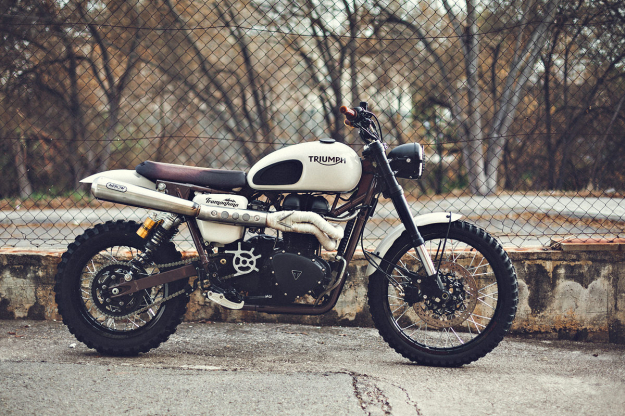
The Scrambler is one of the most-loved Triumph motorcycles of recent times. But there’s a common criticism: its off-road performance doesn’t quite match those beguiling looks.
That shortfall has just been blown to smithereens by a team of five motorcycle engineers. And not just any engineers: they’re all part of Triumph’s own chassis development team, based in Spain and led by brothers David and Felipe Lopez.
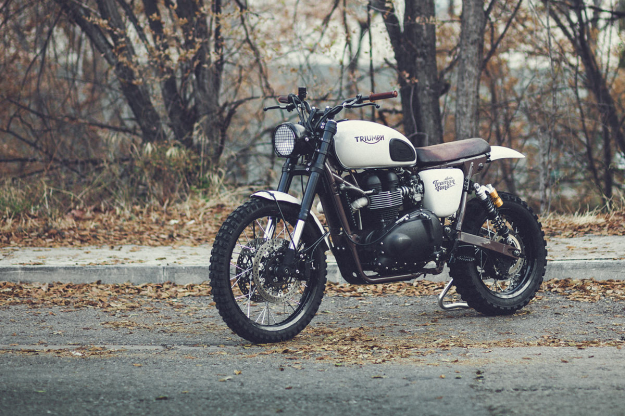
Since 2001, these guys have overseen the development testing of every new Triumph model—so you can guarantee that this custom Scrambler can walk the talk.
The bike is called Tramontana, after a northerly wind that blows over the Pyrenees on the border of France and Spain. “That’s what this Scrambler does—it traverses the mountains as fast and as light as the wind,” says David Lopez.
“During the development of the original Scrambler—launched in 2006—the aim was on-road performance, with the capability for very light off-road riding,” says Lopez. “But even then, it the potential for real off-roading was clear. The 270-degree crank version of the parallel twin allowed excellent traction with a good spread of torque. And the ergos and intuitive character of the chassis made it fun to ride on forest tracks.”
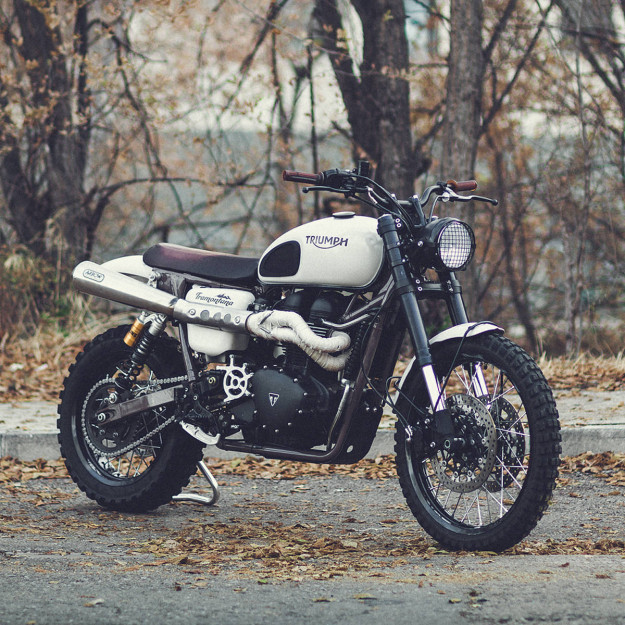
A couple of years later, Lopez and his crew handled the development of the Tiger 800XC. And they got thinking about the good off-road potential of big capacity bikes when purposely developed for it. “Our off-road backgrounds were more related to light bikes—trials and enduro,” says Lopez. “So we were surprised by the pleasure of riding bigger bikes in challenging conditions and terrains.”
Lopez and his team have a soft spot for the Triumph ‘Modern Classics’ range, and had been planning to turn one into a high performance cafe racer. But while developing the 800XC, they decided to change tack—and create the ultimate off-road Scrambler.
It took an extraordinary four years of after-hours work. But this machine has gone through the same chassis development process as an ‘official’ Triumph model, with extensive engineering input and equally extensive test-riding.
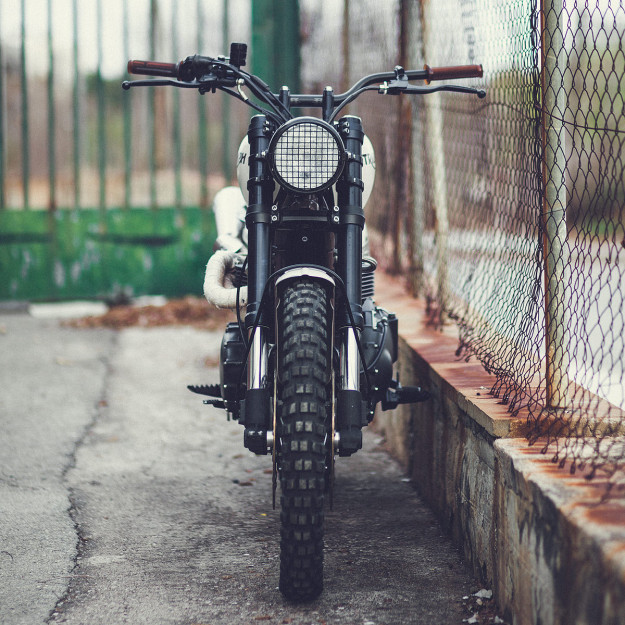
“We investigated countless different geometries, suspension types, wheel sizes, ergonomics and engine configurations,” says Lopez, “just like we’d have done for a production bike. The development decisions were made with only one target: off-road performance.”
Visually, the starting point was a very ‘classical’ Scrambler look, but the finished machine has more of what Lopez calls a ‘modern-retro’ style.
“It’s got the character of the Scrambler and the sixties Triumphs—provided by the parallel twin and the cradle/twin shock frame—mixed with modern high performance.”
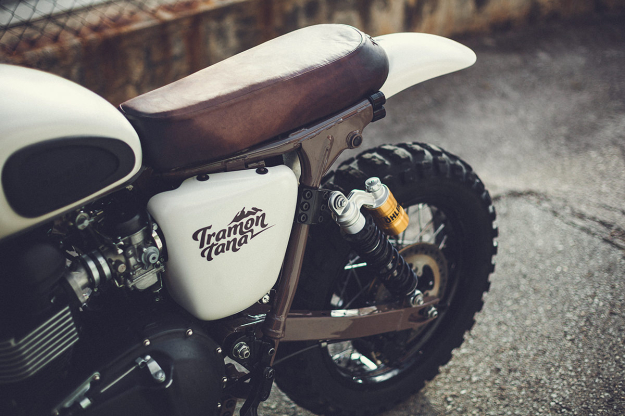
The spec sheet is mouthwatering: multi-adjustable Ohlins suspension, alloy rims, twin front discs, alloy yokes and bars, and a tailor-made Arrow exhaust. Even better is what the bike is missing, to the tune of almost 40kg when weighed next to a stock Scrambler.
As you can imagine, the mods are extensive. So here’s a detailed rundown.
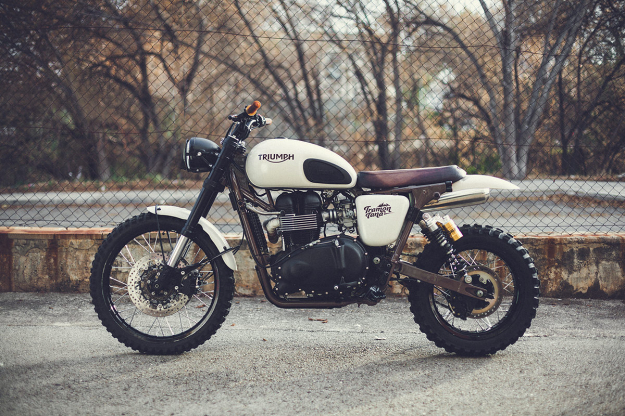
Chassis geometry “The geometry was developed to provide a confidence-inspiring ride, balancing front and rear grip—to allow for easy and predictable rear-wheel drifting.” This geometry was achieved by repositioning the rear suspension unit top mounts, lengthening the swing arm, and by changing the forks and yokes.
Wheel Base: 1510mm (up 10mm)
Caster Angle: 26.1 degrees (down from 27.8)
Trail: 111mm (up from 105mm)
Dry weight: 178kg (down from a real-world 217kg)
Weight Distribution: 48.5% Front – 51.5% Rear
Suspension “The suspension is now Öhlins, and was specifically developed for this bike. We increased the fork stroke from 120mm to 220mm, and the rear wheel stroke from 106mm to 180mm.” The increased rear stroke comes via clamps machined from solid alloy that reposition the top of the rear suspension unit, which also improves progressiveness.
Wheels Lightweight aluminum spoke wheels from Excel, sized 21” x 2.5” at the front and 17″ x 4.25″ at the rear. “The 21” front wheel is essential to achieve the desired level of grip and control of the front end in off-road conditions.”
Frame Modified to reduce weight by eliminating all non-essential features. The steel fork yokes have been replaced by custom aluminum parts.
Ergonomics The steel handlebars and risers have been swapped out for aluminum bars fitted with Tomaselli grips. The footrests are modified genuine Triumph accessory items, in the 1970s ‘bear trap’ motocross style. “Their position has been changed to lower the rider in relation to the center of gravity of the bike, to improve standing up bike control.” The seat is a one-off, covered with Italian brown leather.
Front Brakes Twin 308mm discs (replacing a single 310mm disc) with two-piston floating calipers by Nissin.
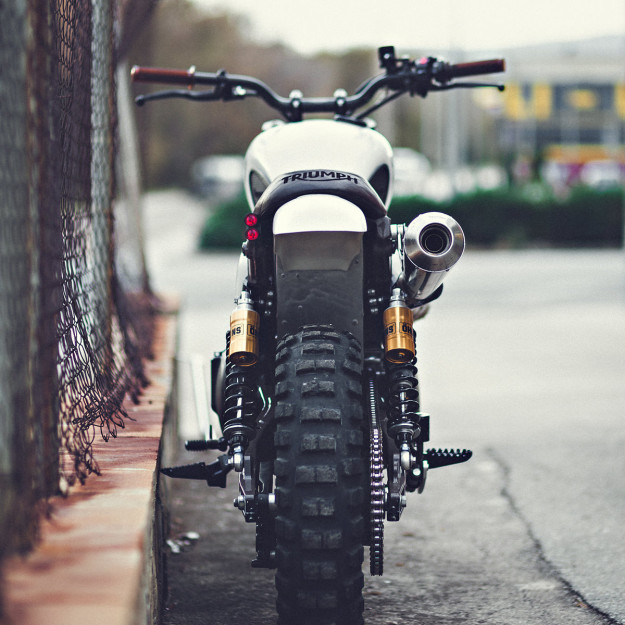
Bodywork Custom-made side panel and rear mudguard. Black anodized aluminum sump guard.
Powertrain Airbox replaced by inlet ports, with individual air filters to improve low and mid-range torque. Re-jetted Keihin carbs. Eliminated secondary air system. Custom-made wiring harness and battery tray. Lithium-Ion battery. Size 17-50 sprockets. Custom-made dynamic chain tensioner.
Exhaust System Custom Arrow brushed stainless steel two-into-one high-level exhaust system, covered with wrapping tape to optimize the exhaust phase.
CNC Machined Components Brake fluid reservoirs, rear brake master cylinder protector, sprocket cover, headlight brackets and protector, twin rear light.
The stock Triumph Scrambler sells for $9,099 in the USA. Perhaps Triumph should take a leaf out of the Street Triple’s book and sell this machine as an ‘R’ version for $11,000—still a grand less than the 800XC. Or put together a kit, so that Scrambler fans can convert their own machines to Tramontana spec.
Would you be tempted?
Images courtesy of Marc Bordons.